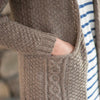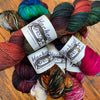This, friends, is a big one. It is the concept at the very core of the art. The math that makes our sweaters fit (or not). The magic that makes every single person's stitches unique. The thing that has made more knitters and crocheters openly weep than any other aspect of our crafts. Gauge.
And it is made even more mysterious by the fact that gauge for knit and crochet are two very different animals. So let's take them one at a time - today we are going to focus on knitting gauge.
What Is Gauge?
At the heart of it, it is the number of stitches per inch (or 4 inches or 10 cm or any other measurement you choose). That's the magic. If you can get the right combination of needle size and yarn thickness to knit the correct number of stitches per inch for whatever pattern you are working on, it will turn out as promised. (Well, if your pattern is good.)
The brutal truth is that most of us won't actually knit to gauge with the "recommended" needle size. There are too many fibers, too many plies, too many types of needles, and to top it all off each of us is a special, unique knitter. We had a swatch board at the store that illustrated this perfectly. The following 4 swatches are 4 knitters- some continental and some English- but all using the same yarn base and weight and the same size needles. This is why you have to knit a swatch first. Really.




KNIT.
A.
SWATCH.
FIRST.
With your *blocked* swatch in hand, it's time to bust out a ruler. (Remember - the swatch has to be washed because you'll certainly be washing your garment at some point and you want it to fit for always, not just the moment it comes off your needles.)
Ok, sorry, back to your swatch and your ruler. There are lots of options out there to help you measure. Most needle gauges have a 2" to 4" ruler on the side and Ann Budd makes a plastic one that you can use to buy holding it over your work and matching the stitches. Essentially, you just need something to measure out a few inches so you can count the stitches.


If by some miracle you have the right number of stitches per inch or centimeter, you are good to go! If not, it's time to try another size needle. This is normal! It will be the exception and not the rule to hit the nail on the head of your first try.
- Too many stitches per inch? Each of your stitches is a little smaller than desired. Congratulations! You are a tight knitter! Go up to a bigger needle size, work a purl row on your swatch, knit another few inches so you can recount. Still off? Lather, rinse, repeat.
- Too few stitches per inch? Each of your stitches is a little bigger than ideal. Hurray! You are a loose knitter! Go down to a smaller needle size, do the purl row on the swatch, knit some more, and then count again. Repeat as needed.
Why Does It Matter?
Gauge matters if you care about the fit of the garment (which you probably do) OR the density/drape of the fabric (again, you probably do) OR if you are worried about running out of yarn.
First let's talk fit. Many of us learn by knitting some sort of square or rectangle like a scarf or a washcloth. Fit is not an issue with either of these. However, once you get to knitting your first hat, or sock, or sweater, you are going to care a whole lot more about how it fits. If every stitch you knit is just a little too small, that's going to add up over the course of a garment and yield a finished object that is way off. And there are few things more disheartening than knitting an entire sweater just to have it turn out several sizes too big or too small.
Drape and density of the fabric can be a concern even for your scarf or washcloth. A washcloth that is too loosely knit will be more hole than fabric once it gets wet. And a scarf that is knit incredibly tightly will wear like a coat of chain mail around your neck - not the fluffy hug you were dreaming of.
As for running out of yarn? If your gauge differs too much from what the pattern says, you could use more or less yarn than expected - little differences in each stitch can add up over an entire garment. Most patterns include a certain amount of leeway in the stated yardage to allow for variations in gauge... but don't rely on that.
The biggest danger is that if you are a tight knitter and working a pattern that calls for you to knit a certain length, you could wind up ultimately knitting far more stitches and thus using far more yarn than the pattern expects. And that means you will run out of yarn before you have a finished project. Boo! No one likes to lose at yarn chicken!
Bottom Line
Getting gauge can be tricky but it is totally worth the effort when you try on your new hand-knit sweater for the first time AND IT FITS.







